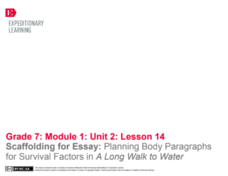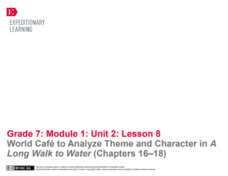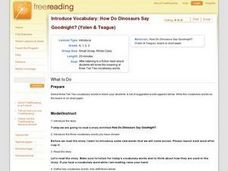EngageNY
Relationships Between Key Scientific Concepts: Planning What Causes Earthquakes
That is ground shaking news! Scholars read Earthquake in multiple reads to determine the gist, identify cause and effect relationships, and understand vocabulary. Learners complete graphic organizers to describe what happens before and...
EngageNY
Synthesizing Text Details to Explain Relationships: “Medicine and Healing”
After reading the section about medicine and healing in The Inuit Thought of It, leaners determine what they feel was the most important resource to surviving in the Arctic environment. They support their opinions with details from the...
EngageNY
Vocabulary Strategies and Questions from the Text: Close Reading Part 2 of The Lightning Thief (Chapter 3, Continued)
That is very unexpected! Scholars take a close look at the word unexpectedly from chapter three of The Lightning Thief. They examine the prefix and think of other words that have the same prefix. Learners regroup in their triads and take...
EngageNY
End of Unit Assessment, Part 1, Continued: Revising Vocabulary and Conventions based on Feedback
Howdy, partner! Scholars partner up to look at the last two rows in the writing rubric. After discussing the details in the rubric about organization and conventions, learners use colored writing tools to circle feedback in their...
EngageNY
End of Unit 2 Assessment, Part 2: Revise Essay Drafts
One last chance to fix it. Writers work through a mini-lesson plan covering common errors found within their essays. They then receive their drafts with instructor feedback and adjust their essays one last time before handing it in for a...
EngageNY
Scaffolding for Essay: Planning Body Paragraphs for Survival Factors in A Long Walk to Water
Some things are complicated. Scholars continue to look at the model essay and rubric related to A Long Walk to Water. This time, they focus only on row three of the rubric because it is a more complicated portion. Writers think about the...
EngageNY
Scaffolding for Essay: Examining a Model and Introducing the NYS Grade 6–8 Expository Writing Evaluation Rubric
Write it down. Scholars take a close look at essay writing by examining the New York state writing rubric. They then discuss a model essay and compare the model essay to the What Makes a Literary Analysis Essay Effective? Anchor Chart....
EngageNY
World Café to Analyze Theme and Character in A Long Walk to Water (Chapters 16–18)
Here comes a surprise ending! Readers discuss their thoughts about the ending of A Long Walk to Water by answering probing questions. They participate in a World Café where they work in triads to complete a chart and a prompt during...
EngageNY
Analyzing Character: Louie Zamperini
Let's talk! Scholars create discussion appointments using map locations. After completing their appointment books, readers look closely at a few Unbroken pages. They use sentence strips to record details from their readings that help...
Curated OER
Introduce Vocabulary: Kindergarten Count to 100
During read-aloud of Kindergarten Count to 100 by Jacqueline Rogers, children listen for context clues about vocabulary that includes the words "first," "second," and "third." I love the way vocabulary development skills are integrated...
Curated OER
Introduce Vocabulary: Hot Air: The (Mostly) True Story of the First Hot Air-Balloon Ride
Young scholars analyze tier two vocabulary words. In this vocabulary instructional activity, students investigate new vocabulary words while reading. Young scholars record their vocabulary words in a word journal or discovery chart.
Curated OER
Introduce Vocabulary: How Do Dinosaurs Say Goodnight?
Students explore tier two vocabulary. In this vocabulary activity, students read How Do Dinosaurs Say Goodnight? and assess the meaning of new vocabulary words found in the story. Students record their new words using a word journal or...
Curated OER
Introduce Vocabulary: It's Pumpkin Time
Students predict the meaning of tier two vocabulary words. In this vocabulary lesson, students investigate the meaning of new vocabulary words while reading It's Pumpkin Time. Students record their new words in a word journal or...
Curated OER
Introduce Vocabulary: My Chinatown: One Year in Poems
Students explore tier two vocabulary words. In this vocabulary lesson, students work in small groups assessing the meaning of new vocabulary words. Students record vocabulary in a word journal or discovery chart.
Curated OER
Introduce Vocabulary: Welcome to the Ice House
Students study tier two vocabulary words. For this vocabulary lesson, students explore new vocabulary words found while reading Welcome to the Ice House. Students assess the meaning of their new vocabulary words and record their learning...
Curated OER
Introduce Vocabulary: Red Riding Hood
Students study tier two vocabulary words. In this vocabulary lesson, students read Red Riding Hood and investigate tier two vocabulary words found in the story. Students analyze the meaning of vocabulary words and record their...
Curated OER
Introduce Vocabulary: Ruby the Copycat
Students analyze tier two vocabulary words. In this vocabulary lesson, students explore vocabulary words used in Ruby the Copycat. Students assess the meaning of new vocabulary words and record their new words in a word journal.
Curated OER
Introduce Vocabulary: Smoky Night
Students investigate tier two vocabulary words. For this vocabulary lesson, students assess the meaning of vocabulary words found while reading Smoky Night. Students record their new vocabulary words using a word journal or discovery chart.
Curated OER
Introduce Vocabulary: The Five Chinese Brothers
Students discover several Tier Two vocabulary words. In this vocabulary lesson, students study Tier Two vocabulary words from the story "The Five Chinese Brothers".
Curated OER
Introduce Vocabulary: The Keeping Quilt
Students consider tier two vocabulary words. In this vocabulary lesson, students investigate the meaning of new vocabulary words found while reading The Keeping Quilt. Students record their new vocabulary words using a word journal or...
Curated OER
Introduce Vocabulary: The Lion and the Mouse
Students determine the meaning of tier two vocabulary words. In this vocabulary lesson, students explore new vocabulary words while reading The Lion and the Mouse. Students record their new vocabulary words in a word journal or discovery...
Curated OER
Introduce Vocabulary: The Lorax
Students analyze tier two vocabulary words. For this vocabulary lesson, students read The Lorax and assess the meaning of vocabulary words found in the story. Students record their vocabulary words in a word journal or discovery chart.
Curated OER
Introduce Vocabulary: The Pilgrims' First Thanksgiving
Students study tier two vocabulary words. In this vocabulary lesson, students explore new vocabulary words while reading The Pilgrims' First Thanksgiving. Students record their new vocabulary words using a word journal or discovery chart.
Curated OER
Introduce Vocabulary: The Reasons for the Seasons
Learners assess the meaning of new vocabulary words. In this vocabulary lesson, students read The Reasons for the Seasons and evaluate the meaning of tier two vocabulary words. Learners record their words using a word journal or...

























